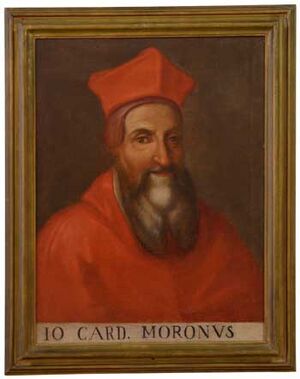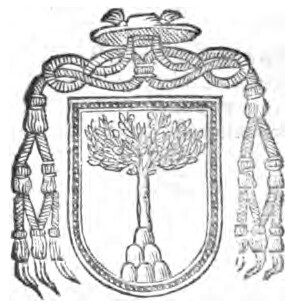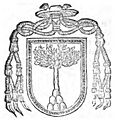Giovanni Morone facts for kids
Quick facts for kids Giovanni Morone |
|
|---|---|
| Cardinal-Bishop of Ostia | |

Portrait of Cardinal Morone by an unknown artist
|
|
| Church | Roman Catholic Church |
| Diocese | Diocese of Ostia |
| See | Ostia |
| Appointed | June 1570 |
| Reign ended | 1 December 1580 |
| Predecessor | Francesco Pisani |
| Successor | Alessandro Farnese |
| Other posts |
|
| Orders | |
| Ordination | 12 January 1533 |
| Consecration | 12 January 1533 |
| Created Cardinal | 2 June 1542 |
| Rank | Cardinal-Bishop |
| Personal details | |
| Birth name | Giovanni Girolamo Morone |
| Born | 25 January 1509 Milan, Italy |
| Died | 1 December 1580 (aged 71) Rome, Italy |
| Buried | Santa Maria sopra Minerva |
| Previous post |
|
Giovanni Morone (born January 25, 1509 – died December 1, 1580) was an important Italian leader in the Roman Catholic Church, known as a Cardinal. He became a bishop in 1529 and was made a Cardinal in 1542 by Pope Paul III. As a Cardinal, he lived in the Vatican City and even gave advice to Saint Ignatius, who started the Jesuits.
Contents
Who Was Giovanni Morone?
His Early Life and Becoming a Bishop
Giovanni Morone was born in Milan, Italy, on January 25, 1509. His father, Count Girolamo Morone, was a very important official there. Giovanni studied law in Padua and was very good at it.
When he was just 20 years old, in 1529, Pope Clement VII chose him to be the Bishop of Modena. This was a way to thank Giovanni's father for helping the Pope during a difficult time. Giovanni was too young to be a bishop then, so he officially became a priest and bishop on January 12, 1533.
Working as a Diplomat for the Pope
Starting in 1535, Pope Paul III often sent Giovanni Morone on important diplomatic missions. These were like special trips to other countries to represent the Pope.
- He went to France to try and make peace between the French King and the Emperor.
- He also traveled to Germany to talk about returning some areas to the Catholic Church.
- In 1542, he was chosen to help open the important Council of Trent. This was a major meeting of Catholic leaders to discuss the Church's future.
On May 31, 1542, Giovanni Morone was made a Cardinal. This was a very high position in the Church. He also became a "protector" for several countries and religious orders, meaning he looked out for their interests in Rome.
His Relationship with Protestants
Giovanni Morone was known for trying to understand the views of Protestants, which was unusual at the time. Because of this, some people suspected he might be too friendly with them.
In 1550, he stepped down as Bishop of Modena but later returned to that role in 1564. He also became Bishop of Novara in 1553.
Imprisonment by the Pope
In 1557, Pope Paul IV ordered Giovanni Morone to be put in prison in Castel Sant'Angelo. The Pope suspected Morone of being a Lutheran (a type of Protestant).
Other Cardinals, led by Cardinal du Bellay, demanded to know why. The Pope said there had been questions about Morone's beliefs for a long time. A group of Cardinals investigated the charges against Morone. They found no proof that he was guilty.
Morone refused to leave prison unless Pope Paul IV publicly said he was innocent. But the Pope, who used to be an Inquisitor (someone who investigated heresy), refused to admit he was wrong. So, Morone stayed in prison until the Pope died in 1559.
Some people believe Pope Paul IV even tried to stop Morone from becoming the next Pope because of his suspicions. However, when Pope Pius IV was elected, Morone's name was cleared, and he was set free.
Important Roles in the Church
After his release, Giovanni Morone continued to hold important positions. He became a Cardinal Bishop of several different areas, including Albano, Sabina, Palestrina, and Porto.
In 1566, he was considered a strong candidate to become the next Pope. He had support from the Emperor and the Spanish. However, he did not get enough votes. Pope Pius V was elected instead.
In 1570, Morone became the Dean of the Sacred College of Cardinals. This is the leader of all the Cardinals. In this role, he also became the Bishop of Ostia and Velletri. He helped make sure the rules from the Council of Trent were followed, especially by holding regular meetings for bishops.
His Later Years and Achievements
Giovanni Morone kept working to solve problems within the Church and to find ways for Catholics and Protestants to get along. He asked someone to research how Protestantism was growing in England.
In 1562, Morone helped Pope Pius IV restart the Council of Trent. He became known as a very skilled mediator, someone who helps opposing sides find common ground. Many people later called him "the savior of the council" because of his efforts. He helped the Council create the Tridentine Creed, which is a set of beliefs for Catholics.
In 1575, during a special religious celebration called the Jubilee, Cardinal Morone led the opening ceremony of the Holy Door at a famous church in Rome. That same year, he helped bring peace to the city of Genoa, which was having civil unrest. He even helped write a new plan for their government.
He died on December 1, 1580, and was buried in the Basilica of Santa Maria sopra Minerva in Rome.
Images for kids




